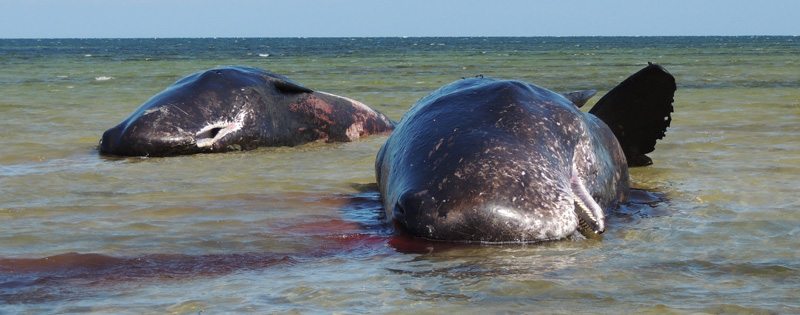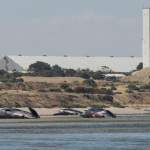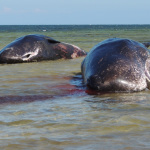The first known group stranding of Sperm whales to occur on South Australia’s coastline was reported near Ardrossan yesterday morning. Among the curious onlookers, members of the Marine Life Society of South Australia attended the scene, where they inspected the bodies of five of the seven deceased whales. While obvious external injuries appeared to be absent from four of the whales, one of the whales showed evidence of propeller strike, a symptom of collision with a vessel at sea.
Marine Life Society of South Australia’s secretary, Dan Monceaux recognised the regular shape and repeated pattern of propeller blade cuts, based partly on his observations of a dead Southern right whale which washed ashore between Tumby bay and Louth Bay on Eyre Peninsula last winter. In that case, the necropsy of the whale confirmed that the animal had received severe blunt trauma to the head in addition to deep propeller cuts.
In the case of the propeller-struck sperm whale at Ardrossan, the cuts were not as deep, but would have been sufficient to traumatise the animal. The animal’s body had also lost some skin and appeared bruised- additional injuries which could be attributable to ship strike.
The Marine Life Society of SA is concerned that poor public knowledge of the protected status of whales, even after their death, may lead scavengers to consider taking a souvenir from the whales, or collecting animal parts for other reasons.
“I overheard a man in the Ardrossan Hotel tell a mate on the phone that he had taken some blubber from a whale. He and others may not be aware that he has committed an illegal act,” said Dan Monceaux, Secretary of the Marine Life Society of South Australia.
Whales and dolphins are protected in South Australia under the National Parks and Wildlife Act, with regulations publicly available via the SA Whale Centre’s website. Human contact with a cetacean is illegal, unless operating under the instruction of a park ranger or assisting an animal which is in distress.
Members of the Marine Life Society of South Australia returned to Ardrossan on December 9 to inspect the other two whales which were inaccessible on the afternoon of the stranding due to the rising tide. There was no further ship strike evidence present on these whales. The follow-up visit also allowed them to confirm that all seven of the dead whales were female. AMWRRO has reported that one of them was lactating, meaning that a calf has been orphaned during or prior to this incident.
“We are disappointed that the scientific analysis of the dead whales only formally commenced today. That has allowed time for public interference with the carcasses and scavenging by sharks. Both of these activities have the potential to mask or remove important evidence from the scene.”
Sperm whales are social mammals. It is possible that a single distressed whale attracted the other whales into dangerously shallow waters where they all perished. While evidence of ship strike is present on one animal, formal necropsy will help to determine or eliminate any other potential causes, such as disease or acoustic trauma.






